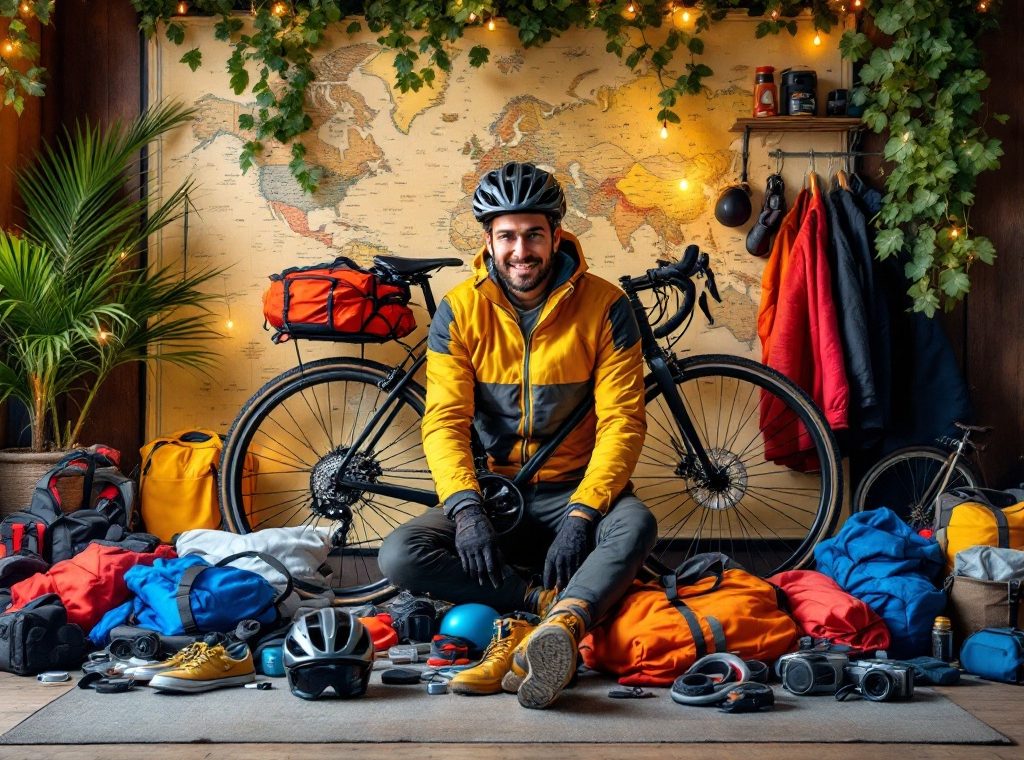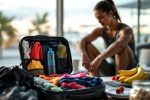Essential Packing Guide for Cyclists Traveling Internationally
Planning an international cycling adventure? Don’t leave home without this comprehensive packing checklist! From essential gear like helmets and repair kits to navigating with GPS and packing for all weather conditions, this guide covers everything. Learn how to efficiently pack your bike and gear, prioritize safety, and travel light. Discover expert tips for hot, cold, and wet weather cycling, ensuring a smooth, enjoyable, and safe journey. Start planning your dream cycling trip now!
Important information

- Essential gear includes a helmet, cycling shoes, and appropriate clothing for varying weather conditions like jerseys, shorts, and gloves.
- Pack a repair kit containing a multi-tool, pump, spare tubes, and tire levers for roadside repairs.
- Bring nutrition and hydration supplies such as water bottles or a hydration pack, energy bars, and gels.
- Ensure you have navigation tools like maps, a GPS device, or a cycling computer, and important documents including your passport, visa (if needed), cash, credit cards, and medications.
- For international travel, service and clean your bike, potentially disassemble it, pack it securely in a box or case, and label it with your contact information.
Comprehensive Packing Checklist for Cyclists
Step 1: Essential Gear
Start with the essentials: a helmet, cycling shoes, and clipless pedals (if used).
Step 2: Clothing
Pack appropriate clothing: jerseys, shorts, and gloves.
Step 3: Repair Kit
Prepare for roadside repairs with a multi-tool, pump, spare tubes, and tire levers.
Step 4: Nutrition and Hydration
Pack for sustenance with water bottles or a hydration pack, energy bars, and gels.
Step 5: Navigation
Ensure you can find your way using maps, a GPS device, or a cycling computer.
Step 6: Important Documents and Medications
Remember essential items like your passport, visa (if required), cash, credit cards, and any necessary medications.
Essential Bike Gear
Your essential cycling kit includes: a bike, a helmet, cycling shoes with cleats, front and rear lights, two large water bottles, spare cleats, cable ties for quick fixes, a saddle bag with a pump, inner tubes, tire levers, a multi-tool, chain lube, and a sturdy bike lock.
Clothing and Apparel
When packing for a cycling adventure, consider the weather at your destination. Essential clothing includes cycling jerseys and shorts, or bibs for added comfort. For colder climates, pack jackets, arm and leg warmers, gloves, and socks. Opt for moisture-wicking, breathable fabrics to stay comfortable on your ride.
Tools and Repair Items
Essential items for your ride include:
- a pump,
- tire levers,
- a multi-tool,
- spare inner tubes (absolutely vital),
- a patch kit (for added security),
- a chain breaker with spare links,
- a portable tire inflator (for even greater ease).
Hydration and Nutrition Needs
- Stay hydrated by packing two water bottles or a hands-free hydration pack.
- For quick energy, bring energy bars, gels, or chews.
- Replenish lost minerals with electrolyte tablets or powder.
- A compact cooking system and a small, insulated food container are invaluable for longer trips, keeping meals and snacks fresh.
Navigation and Electronics
Navigation can be tricky, so consider using a GPS device or a cycling app on your smartphone. Don’t forget a portable charger to keep your devices powered up. A bike computer is also helpful for tracking speed, distance, and other metrics. For low-light conditions, a small flashlight or headlamp is invaluable.
Personal and Travel Essentials
For a smooth trip, bring both cash and a credit card to handle expenses. Before departing, ensure your travel insurance is up-to-date. A money belt is invaluable for safeguarding your passport, credit cards, and other valuables.
Pack travel-sized toiletries and a change of clothes in your carry-on, along with any essential medications, keeping them readily available. Don’t forget practical items like a waterproof phone pouch and hand sanitizer.
Preparing Your Bike for International Travel
Service your bike. Address any mechanical issues and ensure brakes, gears, and tire pressure are optimal for a smooth trip.
Thoroughly clean your bicycle. This is essential to comply with agricultural regulations at your destination.
Disassemble your bike. Depending on airline restrictions and your packing method, you may need to partially or fully disassemble your bike.
Pack your bicycle securely. Use a box or case with ample padding to prevent damage. If using a bike bag, remove the pedals and handlebars, and slightly deflate the tires to accommodate pressure changes during flight.
Label your bike. Clearly label your bike with your contact information and destination address.
Service and Maintenance Tips
Before embarking on an international cycling trip, give your bike a thorough inspection. Test your brakes, ensure smooth gear shifting, and inflate your tires to the proper pressure. Lubricate the chain and tighten any loose bolts. A professional bike service is also highly recommended for optimal performance and to prevent mechanical issues.
Inspect your bike thoroughly. Check brakes, gears, tire pressure, chain lubrication, and bolts.
Consider a professional bike service for optimal performance and to prevent mechanical issues.
Pack a small tool kit with essentials like a multi-tool, tire levers, and a spare tube for roadside adjustments.
With these preparations, you can fully enjoy your international cycling adventure.
How to Pack Your Bike Securely
To ensure your bike travels safely, reserve a spot for it on your flight in advance. Also, confirm that your planned transfers can accommodate a bike box or bag, which is necessary for packing.
Packing Tips for Different Weather Conditions
Wet Weather Essentials
- dress in layers, using synthetic materials that dry quickly.
- Pack a windproof and rainproof jacket, along with waterproof pants, to stay dry.
- Protect your gear with waterproof panniers and bags.
- Use waterproof shoe covers to keep your feet dry and comfortable.
- Bring a small, quick-drying towel for wiping away rain or sweat.
- Pack extra socks and gloves to ensure warm, dry extremities in wet conditions.
Hot Weather Must-Haves
- Wear lightweight, breathable clothing to stay cool.
- Use a cycling cap or helmet liner to wick away sweat and keep your head cool.
- Protect your eyes from the sun with sunglasses.
- Apply high-SPF sunscreen to prevent sunburn.
- Carry a hydration pack or water bottles to stay properly hydrated.
Cold Weather Tips
- Pack a lightweight, insulated vest for extra warmth when temperatures drop.
- Consider wearing leggings for added lower-body protection against the cold.
Layering and Synthetic Materials
Synthetic fabrics like nylon and spandex are ideal for cycling apparel because they wick away sweat, keeping you comfortable on your ride.
Layering is also crucial for adapting to changing weather conditions.
- Start with a base layer.
- Add an insulating mid-layer for warmth.
- Top it off with a lightweight, waterproof outer shell for protection.
This layered approach offers excellent versatility.
Rain Gear and Waterproof Fabrics
Shield yourself from the elements with a waterproof jacket and pants, opting for seam-sealed or fully taped versions for maximum protection.
Boost your defense with waterproof shoe covers or socks.
A dry bag is crucial for keeping electronics and other vulnerable gear safe.
To avoid overheating, choose breathable waterproof materials, ensuring comfort and dryness.
Hot Weather Cycling Essentials
Step 1: Choose lightweight and breathable clothing.
Wear lightweight, breathable jerseys made of moisture-wicking fabric to stay dry and comfortable.
Step 2: Wear padded shorts for comfort.
Padded shorts, or bib shorts, provide essential comfort and support, especially for longer rides.
Step 3: Protect your hands.
Wear fingerless gloves to enhance your grip and reduce hand fatigue.
Step 4: Prioritize safety with a helmet.
Always wear a helmet to protect your head in case of an accident.
Step 5: Shield your eyes with sunglasses.
Sunglasses protect your eyes from the sun’s glare and airborne debris.
Step 6: Protect your skin.
Apply high-SPF sunscreen to prevent sunburn.
Step 7: Stay hydrated.
Carry a hydration pack or water bottles and consider electrolyte tablets or drinks to replenish lost minerals.
Step 8: Be prepared for rain.
Pack a lightweight rain jacket for unexpected showers.
Travel Light: Strategies for Cyclists
Pack light and efficiently for a smooth cycling trip, using a carry-on to avoid airline fees. Before your trip, do a test run with a fully packed bag and remove any excess items if it feels too heavy. Prioritize quick-drying clothes, rolling them to save space, and utilize every nook and cranny, even your shoes. Consider renting a helmet at your destination to save valuable packing room. One extra set of clothes and essential toiletries (TSA liquid rules apply!) will suffice. Safeguard medications and your camera in your carry-on, protecting any fragile items appropriately. A money belt is ideal for securing valuables. Remember your personal item, like a small backpack or purse. Leave tools, excess food, and water at home; these can be purchased upon arrival.
Do a test pack: Pack your bag fully and ride with it to assess the weight. Remove items if it feels too heavy.
Choose quick-drying clothes: Pack clothes that dry quickly, rolling them to maximize space.
Rent a helmet: Consider renting a helmet upon arrival to save packing space.
Limit toiletries: Pack only essential toiletries, adhering to TSA liquid regulations.
Secure valuables: Protect medications, cameras, and other valuables in your carry-on.
Efficient Packing Routine
Smart packing is essential for a smooth cycling trip. Categorize your gear into these categories: bike equipment, clothing, tools, and personal items. This strategy simplifies packing and access. Keep essentials in your carry-on such as: cycling apparel, medications, and eyeglasses, in case your checked luggage is delayed. Consider the destination’s climate. Pack warm layers like vests and leggings for colder climates. If rain is anticipated, a quality rain jacket, extra socks, and gloves are vital. Choose versatile clothing suitable for both cycling and casual wear to save space. Prioritize lightweight, quick-drying synthetic fabrics to minimize laundry.
Space-saving techniques
- Roll clothes instead of folding to prevent wrinkles and maximize space.
- Stuff socks into shoes for extra room.
Before you go
- Test your packed carry-on by carrying it a short distance to ensure a comfortable weight.
- Consider renting a helmet at your destination to avoid transporting a bulky one.
Choosing the Right Carry-on Bag
Pack your carry-on bag with dimensions of 46 linear inches or less and a maximum weight of 11 pounds. Include essential cycling attire, personal items like prescriptions and eyeglasses, and a fresh change of clothes. Remember toiletries, adhering to TSA liquid limits. Safeguard valuables such as prescription medications, your camera, and fragile items in your carry-on. Consider using a money belt for securing important documents like your passport, credit cards, and other travel documents. You are typically allowed one carry-on bag and one personal item, such as a laptop bag or small backpack. However, it is crucial to confirm your specific airline’s baggage requirements and restrictions before traveling.
Health and Safety Considerations for Cyclists
First Aid Essentials
For minor injuries, a well-stocked first aid kit is essential. Pack the following:
- antiseptic wipes,
- bandages,
- gauze pads,
- adhesive tape,
- pain relievers,
- anti-inflammatory medications,
- blister treatment,
- insect repellent.
Small tools such as scissors, tweezers, and safety pins can also be invaluable. A CPR face shield offers added safety.
Sun Protection and Medications
Protecting yourself from the sun is equally important. Pack these items:
- high-SPF sunscreen,
- lip balm,
- sunglasses,
- a hat.
Pack any prescription medications securely and ensure they’re clearly labeled. Over-the-counter remedies for headaches or allergies can also prove useful, especially when traveling to unfamiliar environments.
First Aid Kit Essentials
Pack a well-stocked first-aid kit with essential items. Include antiseptic wipes for cleaning wounds, assorted bandages, gauze pads, and medical tape. Pain relievers such as ibuprofen or acetaminophen are a must, along with blister treatment and anti-diarrheal medication. Don’t forget any personal prescriptions, sunscreen, and insect repellent.
Sun Protection and Medication
When packing for your trip, prioritize sun protection: a high-SPF sunscreen and lip balm with SPF are essential. Remember any prescribed medications, ensuring they’re correctly stored and labeled. Over-the-counter pain relievers, antidiarrheals, and allergy medication are also recommended. Here’s a suggested packing list for your medications and health-related items:
- High-SPF sunscreen, to protect your skin from sun damage.
- Lip balm with SPF, to shield your lips from the sun.
- Prescribed medications, stored correctly and clearly labeled.
- Over-the-counter pain relievers, for managing headaches or other minor aches.
- Antidiarrheal medication, to address potential digestive issues.
- Allergy medication, to alleviate allergy symptoms.


















